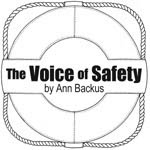Prepared and Practiced Means He’ll Be Home for the Holidays
by Ann Backus

Ann Backus, MS is an Instructor in Occupational Health at Harvard School of Public Health, 665 Huntington Ave., Boston MA 02115, 617/432-3327, abackus@hohp.harvard.edu.
When a boat catches fire one has to act quickly and be ready to change tactics quickly. Fire engulfs a boat in seconds when the fuel becomes involved. The presence of black smoke and intense heat change the game markedly. When the 28-foot wooden lobster boat Dawn Breaker caught fire on November 6, 2015, the captain had to change gears and spring to action.
According to an article in the Boston Globe by Alexandra Koktsidis, the captain first used a fire extinguisher, but realized that the fire was out of control. However, according to his next actions, the captain was apparently in total control of his survival and rescue.
He knew the steps: Radio mayday to the Coast Guard, don the survival suit, pick up the hand-held VHF radio and grab a pre-prepared bag of supplies. Amidst these actions he also activated his personal locator beacon (EPIRB) and gathered up some lobster buoys for additional flotation and visual recognition.
Most likely this lobsterman
had either attended a training
or read numerous safety
bulletins and articles.
What are we able to presume from this incident? Most likely this lobsterman had either attended a training or read numerous safety bulletins and articles. He had clearly given considerable thought to how he would respond should he be faced with a life-threatening situation. In addition to knowing how to make a mayday call, he had a survival suit that fit him and that was within reach and not below deck.
This captain had invested in a personal locator beacon (EPIRB), undoubtedly registered it with NOAA as required, kept it serviceable, and knew how to use it without reading the instructions. The mayday call alerted Coast Guard personnel who in turn perhaps alerted nearby boats; the EPIRB provided search and rescue with the exact location. However it happened, this captain was rescued from the water by two people on a nearby boat within about 20 minutes, according to the Boston Globe article.
The temperature of the water off Crane Beach was probably about 54 degrees F. At this temperature a person would probably become exhausted in a little more than an hour and would likely succumb within 3 hours. The fast thinking of the Dawn Breaker captain to don his survival suit and include a bunch of buoys as he abandoned his boat might well have permitted him to stretch the time to exhaustion, but fortunately he did not need to test this likelihood.
So we can turn this story into a holiday wish list that helps actualize the goal that fishermen and their families and friends are familiar with – that fishermen return home after each trip. Here is a list of gifts that can help ensure ‘home for the holidays’:
Immersion suit – be sure to try on the suit before purchase $300+
VHF hand-held radio $170-270
VHF waterproof case $40
Personal locator beacon/marine use, 406 MHz satelliteresponse $350
EPIRB (mountable, hydrostatic release) $600-$800
Waterproof rapid ditch bag (with PLB/EPIRB pocket, lights, etc.) $120
In addition to having appropriate safety items, other preparedness actions include enrolling in marine safety training and signing up for a voluntary dockside exam with the USCG marine safety office. It is clear that this captain had the “right stuff” and had undertaken focused hands-on and mental practice of the steps of marine self-rescue on his vessel. He’ll be home for the holidays.
Enjoy your Holidays!
